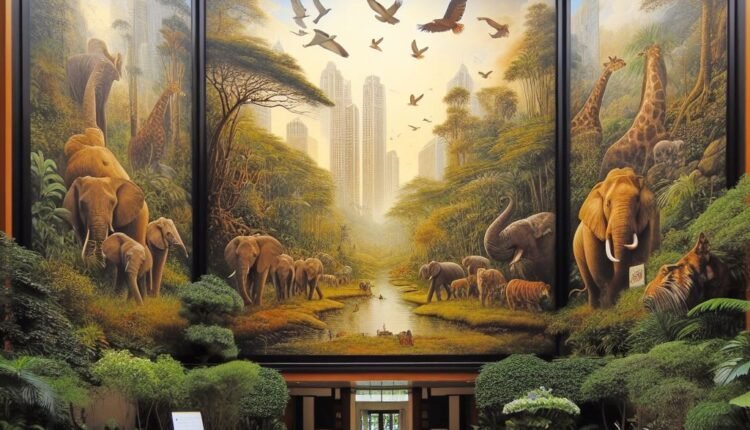Zoo environments have undergone a remarkable transformation over the years, evolving from simple exhibits to complex ecosystems designed for the well-being of both animals and visitors. This paradigm shift has seen the integration into art of the zoo design, creating a harmonious blend that enhances the overall experience. In this article, we delve into the profound influence art of the zoo environments, exploring its historical roots, impact on animal welfare, and its role in educating and engaging the public.
The Evolution of Zoo Design
Historical Overview of Zoo Environments
Zoo, once characterised by stark cages, have evolved into spaces that prioritise the physical and mental health of animals. Early zoo exhibits focused on the mere display of exotic creatures, often neglecting their natural needs. However, as our understanding of animal behaviour and welfare grew, so did the approach to designing enclosures.
Factors Influencing Zoo Design
- Animal Welfare: Modern zoos prioritise the well-being of animals, incorporating elements that mimic their natural habitats. This shift has been fueled by a growing awareness of the psychological and physical needs of captive animals.
- Conservation Goals: Zoos today are not just showcases; they are active participants in global conservation efforts. Enclosures are designed not only for public display but also for breeding programs and research, contributing significantly to species preservation.
- Educational Objectives: Beyond mere observation, zoos aim to educate visitors about the importance of wildlife conservation. Art plays a pivotal role in conveying these messages, acting as a bridge between the scientific and emotional aspects of conservation.
Art’s Impact on Zoo Architecture
Integration of Artistic Elements
- Sculptures and Installations: Sculptures strategically placed within enclosures serve both aesthetic and functional purposes. They provide physical enrichment for animals and offer visitors unique perspectives on the wildlife they are observing.
- Murals and Paintings: Vivid murals and paintings not only beautify zoo walls but also contribute to creating immersive environments. These art forms can represent the natural habitats of the animals, fostering a deeper connection between visitors and the creatures they are observing.
Case Studies of Art-Influenced Enclosures
- Notable Examples Around the World: The Singapore Zoo’s “Rainforest Kidzworld” features vibrant sculptures and interactive art installations, creating an engaging space for both children and animals.
- Success Stories and Positive Outcomes: Research indicates that animals in enriched environments, including those with artistic elements, exhibit reduced stress levels and engage in more natural behaviours.
Enrichment and Education through Art
Behavioral Enrichment for Animals
- Incorporating Stimulating Art for Animals: Enrichment programs often include art-based stimuli, such as puzzle feeders and interactive installations. This not only keeps animals mentally stimulated but also encourages problem-solving and exploration.
- Creating Naturalistic Environments: Artistic elements are seamlessly integrated into enclosures to mimic natural habitats, providing animals with a sense of security and promoting their physical and mental well-being.
Educational Opportunities for Visitors
- Interpretation through Art: Informational panels accompanied by artistic representations help convey educational messages in an engaging manner. Visitors are more likely to remember and internalise conservation lessons when presented alongside visually appealing art.
- Interactive Learning Spaces: Zoos are increasingly incorporating interactive art installations that allow visitors to participate actively in the learning process. This hands-on approach enhances the overall educational experience.
The Role of Public in Art of the Zoo Engagement
Art serves as a powerful tool in fostering connections between visitors and wildlife. The visual appeal of well-designed enclosures enhances the overall visitor experience, encouraging repeat visits and fostering a sense of stewardship towards the environment.
Fostering Connection between Visitors and Wildlife
Visitors are more likely to connect emotionally with animals when their enclosures are aesthetically pleasing. This connection, in turn, can lead to increased awareness and support for conservation efforts.
Impact on Visitor Experience and Satisfaction
Studies have shown that the inclusion art of the zoo environments positively influences visitor satisfaction. Well-designed spaces, coupled with informative art installations, create a more enjoyable and memorable experience for patrons.
Balancing Aesthetics with Conservation Messaging
While aesthetics are crucial for engaging visitors, it’s essential to strike a balance with conservation messaging. Art should not overshadow the primary purpose of zoos, which is education and conservation.
Collaborations between Artists and Zoo
Artist-in-Residence Programs
Zoos are increasingly partnering with artists through residency programs, allowing them to observe and draw inspiration from the animals. This collaboration results in unique art pieces that reflect the essence of the zoo and its inhabitants.
Community Engagement and Local Artists
Engaging local artists not only supports the community but also brings a unique perspective to zoo design. Local art can reflect the cultural and ecological context of the region, adding a layer of authenticity to the zoo experience.
Benefits and Challenges of Collaborative Initiatives
- Benefits: Collaborations enrich the zoo experience for both visitors and animals. They bring fresh perspectives, foster creativity, and contribute to a vibrant community culture.
- Challenges: Balancing the creative vision of artists with the practical considerations of zoo management can pose challenges. Ethical considerations must also be carefully navigated to ensure the well-being of the animals.
Challenges and Considerations
Ethical Concerns in Artistic Zoo Exhibits
- Balancing Aesthetics with Animal Welfare: The pursuit of artistic excellence should not compromise the health and well-being of the animals. Enclosures must prioritise the needs of the inhabitants over purely aesthetic considerations.
- Potential Controversies and Criticisms: Artistic choices in zoo design may face scrutiny from animal rights activists and the public. Open communication about design decisions and their rationale is essential to address concerns.
The Future in Art of the Zoo Environments
Emerging Trends and Innovations
- Technology and Virtual Art Installations: Virtual reality and augmented reality are being explored as tools to enhance the zoo experience. These technologies can create immersive art installations that dynamically respond to visitor interactions.
- Sustainable and Eco-Friendly Designs: As environmental consciousness grows, zoos are incorporating sustainable and eco-friendly art installations. These designs not only contribute to conservation efforts but also align with the broader ethos of responsible environmental stewardship.
Visitor Expectations and the Changing Role of Zoo
As visitors become more discerning, their expectations of zoos evolve. Zoo are transitioning from being mere showcases to active participants in conservation and education. The integration art of the zoo is poised to play a crucial role in meeting these changing expectations.
Practical Tips for Zoo and Artists
Guidelines for Effective Integration
- Collaboration Best Practices: Establish clear communication channels between zoo management and artists to ensure a harmonious partnership.
- Balancing Artistic Vision with Conservation Goals: Artistic elements should align with the overarching goals of the zoo, prioritising the welfare of animals and promoting conservation awareness.
Conclusion
In conclusion, the marriage art of the zoo and environments represents a transformative journey from canvas to enclosure. This symbiotic relationship enhances the well-being of animals, educates and engages visitors, and contributes to the broader goals of conservation. As we look to the future, the integration of art in zoos is not just a trend but a fundamental aspect of creating immersive and impactful wildlife experiences.


